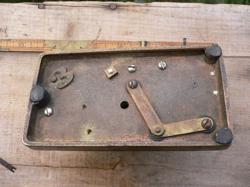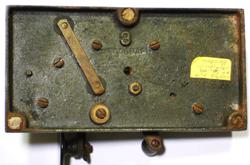The Mecograph
Some other really neat bugs were made by The Mecograph Company in Cleveland Ohio. In 1904, William Coffe invented his first mechanical semi-automatic telegraph key which he called the Mecograph. The interesting thing is that his patent preceded Horace Martin's mechanical Vibroplex patent by 4 months, which set off a long round of court battles for the right to produce these new telegraph keys. Coffe partnered with Benjamin Bellows in 1907 to produce the Mecograph keys. More information about this legal battle can be read in Bill Holly's book "The Vibroplex Company", available from The Vibroplex Company. The Mecograph company was eventually purchased by Vibroplex in 1913.
(Click on the pictures below to see larger versions of the photo)
First Model Mecograph (1904)
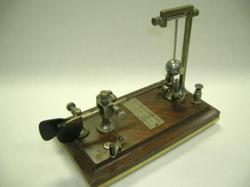 |
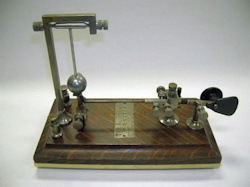 |
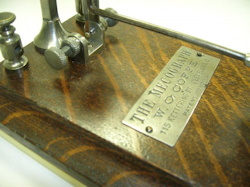 |
The first Mecograph key was a bizarre looking contraption with a keying lever at one end and a vertical swinging pendulum at the other end.
Although they produce automatic dots and manual dashes like a Vibroplex, Mecograph keys operate on a very different principle. Vibroplex keys produce automatic dots by striking the dot lever against a fixed post, causing the pendulum to oscillate from side to side. However with the Mecograph, the dot lever has a spring which puts tension on the pendulum when at rest. When the dot lever is moved, tension is released from the pendulum, causing it to oscillate from side to side just like a Vibroplex. Because of this design, Mecograph keys require less force to operate than a Vibroplex. However, the first Mecograph Model was very difficult to adjust which is why it was only around for a short time before improvements were made.
Below are pictures and descriptions of each of the Mecograph models. Below that is a list of Mecograph patents, followed by a link to a table of Mecograph serial numbers that I have recorded over the years, which can help the collector determine the date of their key.
Mecograph Combo Model (Model 2) (1905-1906)
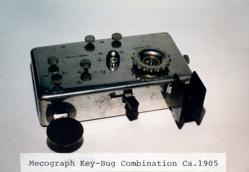 |
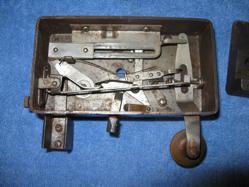 |
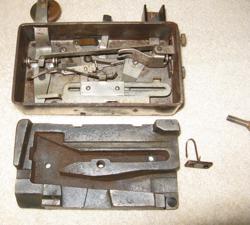 |
(Left picture Gil Schlehman K9WDY collection. Center and right picture Lynn Burlingame N7CFO collection) |
The Combo Model consisted of a straight key and a bug inside a metal box. Although the known serial numbers suggest that hundreds of these were made, only about 3 are known. (Photos courtesy of N7CFO)
Unknown Possible Mecograph Model (1905-1906)
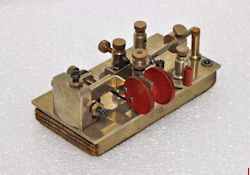 |
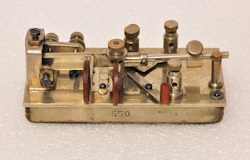 |
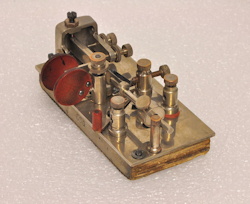 |
An unmarked, right angle bug that is believed to be made by Mecograph. The key is known from 2 examples; both having serial numbers in the 500 range (518 and 550). This places these keys within the large serial number gap of Mecograph Combo bugs. Also, one of the keys was found in a Mecograph carrying case, which lends further credence to being a Mecograph key.
(Refer to the list of Mecograph serial numbers)
Model 3 - Square Weight Version (1906-1908)
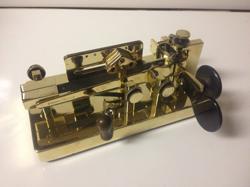 |
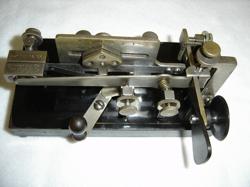 |
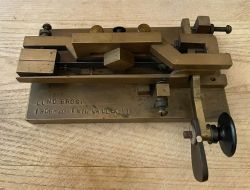 |
|---|
The Model 3 was by far the most popular and widely known of the Mecograph models. The design changed over the years but they all have a keying lever that is at right angles to the vibrating pendulum. The first Model 3 version was an all-brass key that had a large #3 cast into the underside of the base.
It can also be recognized by the square weight and spade-shaped speed adjustment part. Later, the brass base was replaced with a steel base which was finished either with black lacquer or nickel plated. The keying mechanism parts of these bugs were nickel plated.
The picture on the far right is a well-made copy of the Mecograph Model 3 made by the Lund Brothers in Twin Valley, Minnesota, ca. 1920
Model 4 (1906)
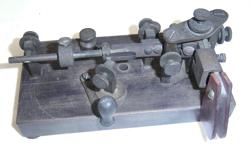 The Model 4 appeared for a short time in 1906. At first glance it looks much like the Model 3, although there is a very important difference. Notice there is no spring tensioner arm (Although the advertisements and patent drawing for the key showed a tensioner arm). So although the lever is at right angles to the pendulum, the key actually operates just like a Vibroplex; i.e. the dot lever strikes against a fixed post to cause the mechanical oscillations. The Model 4 also represents a cost reduction, replacing the expensive machined parts with an assembled frame. In addition the dash lever pivots on a set of 4 tiny ball bearings. This probably led to the demise of this key, since if the key went out of adjustment, it was easy to lose the ball bearings.
The Model 4 appeared for a short time in 1906. At first glance it looks much like the Model 3, although there is a very important difference. Notice there is no spring tensioner arm (Although the advertisements and patent drawing for the key showed a tensioner arm). So although the lever is at right angles to the pendulum, the key actually operates just like a Vibroplex; i.e. the dot lever strikes against a fixed post to cause the mechanical oscillations. The Model 4 also represents a cost reduction, replacing the expensive machined parts with an assembled frame. In addition the dash lever pivots on a set of 4 tiny ball bearings. This probably led to the demise of this key, since if the key went out of adjustment, it was easy to lose the ball bearings.
Model 3 - Round Weight Version (1908-1911)
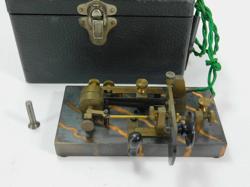 |
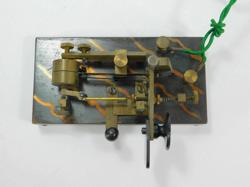 |
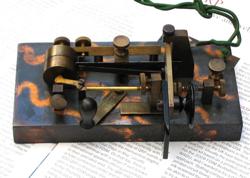 |
|---|
In 1908 the Model 3 was redesigned to be a bit smaller with 2 large round weights, although the operating principle was the same as the earlier square weight Model 3. The long spring tensioner arm was replaced by a small spring loaded cam mounted on a post next to the weights. The standard finish for this key is often referred to as a "tiger stripe" finish; however, it is actually an example of a "Japanned" finish that was often applied to metal fixtures and jewelry. The steel base was first copper plated, then blued, then the "stripes" were produced by applying a chemical to wipe off the blueing in a striped pattern. Unfortunately, only a very thin lacquer coating was applied afterwards, which did not offer much protection, so the bases on many of these Mecograph tiger stripe keys were badly rusted to the point that the stripes can no longer be seen. There are some fine examples of the tiger stripe finish, however, on keys that were kept in dry environments and protected from the elements.
Model 5 (1908)
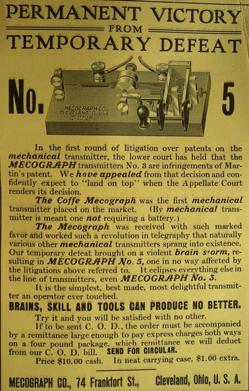 |
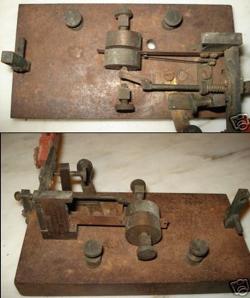 |
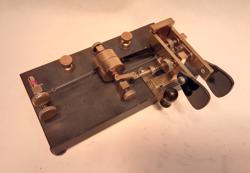 |
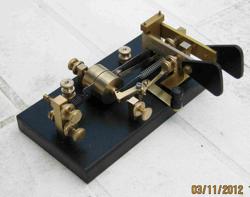 |
Advertisements for the Model 5 appeared in magazines in 1908; however only one incomplete example of this model has ever been found. Picture 3rd from left above is the same key restored by Gil Schlehman, K9WDY. Ron Ayling, G3YUH, made a beautiful identical copy of the key, which can be seen at upper right.
Mecograph Premier - (1911-1913)
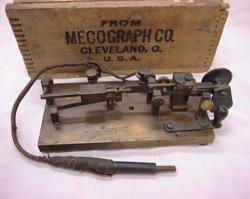 |
The Mecograph Premier represented a major departure from the earlier designs. This bug has a keying lever that is in-line with the pendulum and operates exactly like a Vibroplex bug. This was also an all-brass key like the first version of the Model 3. After production of this key ceased, the company went back to making the round weight Model 3 for a short time before the company was bought by Vibroplex in 1913. Premier Model keys with serial numbers above 12,000 were built using a steel base that was brass plated and lacquered.
Model 3 - Round Weight Version -Solid Base (1913)
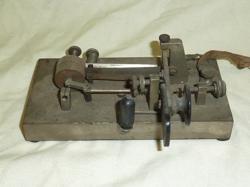 |
 |
 |
|---|
Before The Mecograph Company was bought by Vibroplex, they brought back the round weight Model 3 for a brief time. They were identical to the earlier key, but the components were built on a solid steel base of the same dimensions as the Mecograph Premier base instead of a cast hollow steel base. These keys had serial numbers above 14,000.
The Vibroplex Premier (1913)
 |
An unusual key very similar to the Mecograph Premier, made after Vibroplex bought the company in 1913. This is the only known example of this rare key. |
Mecograph Patents:
Coffe Vertical Pendulum Mecograph (Model 1): 812183a, 812183b
Mecograph Combo Model (Model 2): 886755a, 886755b
Model 4 Mecograph: 855085a, 855085b
Model 5 Mecograph: 939383a, 939383b
Mecograph Serial Numbers:
As I mentioned above, I have been compiling a list of Mecograph serial numbers from keys that I see on Ebay or from other collectors. As with Vibroplex keys, Mecograph numbered their keys sequentially, which when coupled with data from advertisements, allows you to learn the year the key was made and more importantly, to estimate how many keys of each model were made. To see the full list of Mecograph serial numbers, click here.
From the data in the serial number table, we can estimate the production numbers of each model as follows:
Model 1: Unknown. Only a couple original examples known to exist and they had no serial numbers.
Combo Model (Model 2): Possibly up to 1000, although only 3 examples have ever been seen.
Model 3 Square-Weight Version: ~2000 keys
Model 3 Round-Weight Version: ~6000 keys
Model 4: Unknown. Only 7 examples known to exist.
Model 5: Unknown. Only a single incomplete example known.
Premier Model: ~3000 keys
Model 3 Round-Weight (Late Version): ~500 keys
Vibroplex Premier: Unknown. Only a single example exists.

